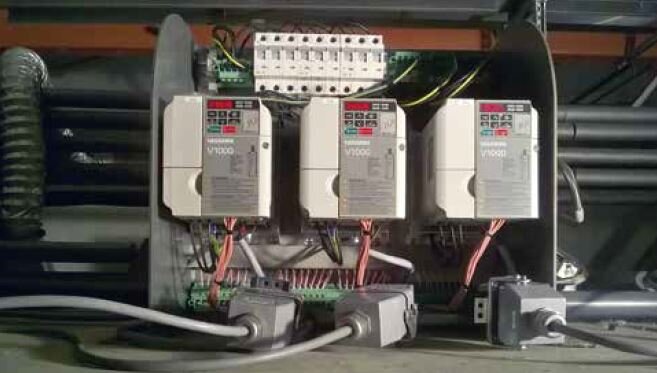Yli 100 vuoden sitoutuminen tekniseen kehitykseen on tehnyt meistä johtavan valmistajan muuttuvien AC-taajuusmuuttajien, servokäyttöjen, ohjaustekniikan ja robotiikan aloilla.
Dutch poultry hatchery retrofits fans with high-efficiency IE4 motors
- Toimialat
- Maatalous
- Asiakasohjelma
- Probroed & Sloot
Four Wins
With its five ultra-modern hatcheries, Dutch company Probroed & Sloot is setting standards in the production of high-quality day-old chicks. And on the subject of sustainability: the decisionmakers are constantly in search of new solutions for reducing energy requirements. Currently the drive units of about 200 air circulation fans are being retrofitted with Yaskawa motors of the highest efficiency class IE4.
A complex poultry production chain is needed to ensure that an egg becomes a healthy and efficient broiler. Probroed & Sloot, based in Groenlo, Netherlands, is an incubation specialist. In its five hatcheries in the Netherlands and Germany the independent company produces day-old chicks of the finest quality. The prerequisites are many years of experience and a strong innovative spirit – also apparent in its in-house research and development department. For example, a special track & trace system enables tracing of every single chick.
Probroed & Sloot is pursuing equally exacting goals in terms of sustainability. A special focus has been placed on energy saving. For example, the heat from the waste air is recovered and re-used. In their latest optimization project the decision-makers at Probroed & Sloot turned their attention to the air circulation fans in the incubators. About 200 of them are in operation at its Groenlo location alone – round the clock, seven days a week. This permanent load provides additional justification for the measures to boost energy efficiency.
Highest efficiency
Probroed & Sloot had opted for frequency inverter-driven asynchronous motors, even before the latest modernization of the fan drives. The electronic control of motor speed makes a substantial contribution to energy saving. Particularly under this aspect, the European ErP Directive (energy-related products), also known as the Ecodesign Directive (2005/32/EC and 2009/125/EC), concerns itself with the use of inverters. It was adopted by the European Commission in 2005 for the purpose of regulating the environmentally compatible design of energy-related products at EU level. Two critical work phases have been completed. The third began in early 2015.
Primarily the requirements for the efficiency of individual products were defined in the first two work phases. Among other things, changes ensuing from the ErP Directive have had the effect that since 2011 only motors conforming to “Efficiency class IE2 or higher” may be put on the market. The drives previously installed at Probroed & Sloot already conformed to this efficiency class.
Generally higher efficiency is offered by permanent magnet motors (PM motors), which in contrast to asynchronous motors must always be controlled by an inverter. Today they satisfy by default the requirements of IE3 (premium efficiency class). Highly efficient PM motors are also now available which satisfy or even exceed the requirements of the highest efficiency class IE4 according to IEC TS 60034-31.
In the light of the above, Probroed & Sloot decided to submit the models of various manufacturers to a practical test. For this purpose, half of each incubator was equipped with new fan drives. Six fans work in a chamber, three left and three right. The test set-up also enabled the consumption of the three existing asynchronous motors to be compared with that of the three new motors under absolutely identical conditions.
SPRiPM Permanent Magnet Motor
Yaskawa SPRiPM permanent magnet motor (Super Premium IPM motor, pronounced “supreme”) clearly prevailed in the test. It is being marketed in the Netherlands by MCA Motion Control Automation B.V. This highly efficient motor is supplied as a drive package together with a V1000 or A1000 frequency inverter and covers an exceptionally broad IE4-compliant range. The energy savings measured at Probroed & Sloot were – compared to IE2 asynchronous motors – around 14% at the nominal point and around 50% in the partial load range more critical for the application.
In addition to excellent energy efficiency, the SPRiPM is characterized by an extremely compact design. On account of their design, PM motors are significantly smaller and lighter than a comparable asynchronous motor. In the latest stage the dimensions were further reduced, so that the new motor is up to 40% smaller than a comparable asynchronous motor. This is equivalent to a two standard sizes smaller frame dimension. Furthermore, the SPRiPM weighs 50% less and has 60% less mass inertia than an asynchronous motor. That means 60% faster start-up and stopping times.
In conjunction with a proven Yaskawa inverter V1000 or A1000, the motor forms a powerful and technically uniform IE4 drive package for diverse applications. The motor-specific parameters are already integrated into the inverter software. The plant engineer only needs to connect the motor-inverter package. In applications with a variable torque – as with fans – a special function “Flying Start” brings positive effects. In the event of a power outage, e.g. the fan wheel continues to turn. The SPRiPM and V1000 or A1000 control the speed down to 5% of the rated level, thus permitting an optimum restart. The low noise level of the motor is especially critical in the case of the fans, as such noise would be amplified by the fan blades.
Conclusion
The Dutch hatchery specialists at Probroed & Sloot set a high standard for themselves not only in the quality of their day-old chicks, but also when it comes to sustainability. In view of the round-the-clock operation of the incubators, measures to boost energy efficiency are particularly worthwhile. The company is successively replacing the existing IE2 asynchronous motors in about 200 air circulation fans with high-efficiency Yaskawa SPRiPM motors which satisfy the currently highest efficiency class IE4. The energy savings are around 50% in the partial load range critical for the application.





















